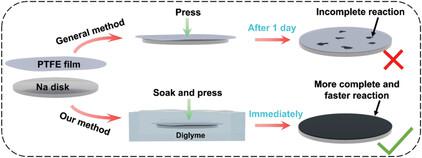Our official English website, www.x-mol.net, welcomes your
feedback! (Note: you will need to create a separate account there.)
Rapidly Constructing Sodium Fluoride-Rich Interface by Pressure and Diglyme-Induced Defluorination Reaction for Stable Sodium Metal Anode
Small ( IF 13.0 ) Pub Date : 2023-02-08 , DOI: 10.1002/smll.202207540 Wu Zhang 1 , Xiaoke Yang 1 , Juncheng Wang 1 , Jiale Zheng 1 , Ke Yue 1 , Tiefeng Liu 1 , Yao Wang 1 , Jianwei Nai 1 , Yujing Liu 1 , Xinyong Tao 1
Small ( IF 13.0 ) Pub Date : 2023-02-08 , DOI: 10.1002/smll.202207540 Wu Zhang 1 , Xiaoke Yang 1 , Juncheng Wang 1 , Jiale Zheng 1 , Ke Yue 1 , Tiefeng Liu 1 , Yao Wang 1 , Jianwei Nai 1 , Yujing Liu 1 , Xinyong Tao 1
Affiliation

|
Sodium (Na) metal is able to directly use as a battery anode but have a highly reductive ability of unavoidably occurring side reactions with organic electrolytes, resulting in interfacial instability as a primary factor in performance decay. Therefore, building stable Na metal anode is of utmost significance for both identifying the electrochemical performance of laboratory half-cells employed for quantifying samples and securing the success of room-temperature Na metal batteries. In this work, we propose an NaF-rich interface rapidly prepared by pressure and diglyme-induced defluorination reaction for stable Na metal anode. Once the electrolyte is dropped into the coin-type cells followed by a slight squeeze, the Na metal surface immediately forms a protective layer consisting of amorphous carbon and NaF, effectively inhibiting the dendrite growth and dead Na. The resultant Na metal anode exhibits a long-term cycling lifespan over 1800 h even under the area capacity of 3.0 mAh cm−2. Furthermore, such a universal and facile method is readily applied in daily battery assembly regarding Na metal anode.
中文翻译:

通过压力和二甘醇二甲醚诱导的脱氟反应快速构建稳定钠金属阳极的富氟化钠界面
钠(Na)金属能够直接用作电池阳极,但具有高还原能力,不可避免地会与有机电解质发生副反应,导致界面不稳定,这是性能下降的主要因素。因此,构建稳定的钠金属负极对于确定用于量化样品的实验室半电池的电化学性能和确保室温钠金属电池的成功具有至关重要的意义。在这项工作中,我们提出了一种通过压力和二甘醇二甲醚诱导的脱氟反应快速制备的富 NaF 界面,用于稳定的 Na 金属阳极。一旦将电解液滴入纽扣电池并轻轻挤压,钠金属表面立即形成由无定形碳和 NaF 组成的保护层,有效抑制枝晶生长和死Na。即使在 3.0 mAh cm 的面积容量下,所得的钠金属负极也表现出超过 1800 小时的长期循环寿命-2。此外,这种通用且简便的方法很容易应用于有关钠金属负极的日常电池组装中。
更新日期:2023-02-08
中文翻译:

通过压力和二甘醇二甲醚诱导的脱氟反应快速构建稳定钠金属阳极的富氟化钠界面
钠(Na)金属能够直接用作电池阳极,但具有高还原能力,不可避免地会与有机电解质发生副反应,导致界面不稳定,这是性能下降的主要因素。因此,构建稳定的钠金属负极对于确定用于量化样品的实验室半电池的电化学性能和确保室温钠金属电池的成功具有至关重要的意义。在这项工作中,我们提出了一种通过压力和二甘醇二甲醚诱导的脱氟反应快速制备的富 NaF 界面,用于稳定的 Na 金属阳极。一旦将电解液滴入纽扣电池并轻轻挤压,钠金属表面立即形成由无定形碳和 NaF 组成的保护层,有效抑制枝晶生长和死Na。即使在 3.0 mAh cm 的面积容量下,所得的钠金属负极也表现出超过 1800 小时的长期循环寿命-2。此外,这种通用且简便的方法很容易应用于有关钠金属负极的日常电池组装中。

































 京公网安备 11010802027423号
京公网安备 11010802027423号